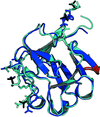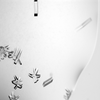issue contents
February 2007 issue

Cover illustration: Cyclophilin from Leishmania donovani at 1.97 Å resolution [Venugopal et al. (2007), Acta Cryst. F63, 60].
protein structure communications
The crystal structure of cyclophilin from L. donovani at 1.97 Å resolution exhibits conservation of the cyclosporin binding site with respect to human cyclophilin.
PDB reference: cyclophilin, 2haq, r2haqsf
The structure of rat acidic fibroblast growth factor was determined and compared with those of human, bovine and newt origin. The rat and human structures were found to be very similar.
PDB reference: rat acidic fibroblast growth factor, 2j3p, r2j3psf
crystallization communications
Crystallization of the transcription termination factor NusA under microgravity conditions significantly reduced the twinning content (1.0%) compared with terrestrially grown crystals (18.3%) and improved the maximum resolution from 3.0 to 2.29 Å, with similar unit-cell parameters.
Cryptolepain is a stable glycosylated novel serine protease was crystallized by hanging-drop method. Crystal data was processed up to 2.25 Å with acceptable statistics and structure determination of the enzyme is under way.
Crystals of the RNA-dependent RNA polymerase catalytic domain from the dengue virus NS5 protein have been obtained using a strategy that included expression screening of naturally occurring serotype variants of the protein, the addition of divalent metal ions and crystal dehydration. These crystals diffract to 1.85 Å resolution and are thus suitable for a structure-based drug-design program.
To potentially gain insight into the conformational origins of substrate recognition by the enzyme from Escherichia coli, cocrystallization experiments were carried out with RNase HI–dsRNA (enzyme–inhibitor) complexes. Crystals were obtained of two complexes containing 9-mer and 10-mer RNA duplexes that diffracted X-rays to 3.5 and 4 Å resolution, respectively.
Crystals of MotY, a stator protein of the V. alginolyticus polar flagellar motor, have been produced and characterized by X-ray diffraction.
Porcine rotavirus strain OSU VP8* domain has been expressed, purified and crystallized. X-ray diffraction data from different crystal forms of the VP8* domain have been collected to 2.65 and 2.2 Å resolution, respectively.
To elucidate the mechanism of regulation of aspartate kinase, the regulatory subunit (the β subunit of T. thermophilus aspartate kinase) was crystallized in the presence of the inhibitor threonine.
Human Atg4B and LC3 were expressed, purified and crystallized as a complex. Diffraction data were collected to a resolution of 1.9 Å.
DHNA synthetase from G. kaustophilus has been cloned, expressed, purified and crystallized.
FabG from A. aeolicus, a putative component of fatty-acid synthase II, has been overexpressed, purified and crystallized. Diffraction data have been collected to 1.8 Å resolution.
Open  access
access
 access
accessCrystallization and preliminary X-ray diffraction analysis of the two domains of DnaD from B. subtilis is reported.
Heat-shock protein Hsp33 from S. cerevisiae was crystallized and diffraction data were collected to 2.7 Å resolution.
Open  access
access
 access
accessAn ω-amino acid:pyruvate transaminase from C. violaceum has been purified and crystallized in two crystal forms. The structure has been solved using molecular replacement.
DtsR1, a carboxyltransferase subunit of acetyl-CoA carboxylase from C. glutamicum, was crystallized and phases were obtained by molecular replacement.
Recombinant D-tagatose 3-epimerase from P. cichorii was purified and crystallized. Diffraction data were collected to 2.5 Å resolution.
Glycerol kinase from the hyperthermophilic archaeon Thermococcus kodakaraensis was crystallized and preliminary crystallographic studies of the crystals were performed.
A novel cardiotoxin-like basic protein from Naja naja atra was crystallized and diffraction data were collected to 2.35 Å resolution.
In situ proteolysis with fungal protease or subtilisin is crucial for the crystallization of murine CstF-77.
The K349P mutant of Gαi1, which is unable to couple to G-protein-coupled receptors, has been crystallized and analyzed. The same crystallization conditions were applicable irrespective of the identity of the bound nucleotide or of the presence of the mutation.
Pz peptidase A has been cocrystallized with a phosphine peptide inhibitor (PPI) that selectively inhibits thimet oligopeptidase and neurolysin.
international union of crystallography
Free 



 journal menu
journal menu


































![[publBio]](http://journals.iucr.org/logos/publbio.gif)





